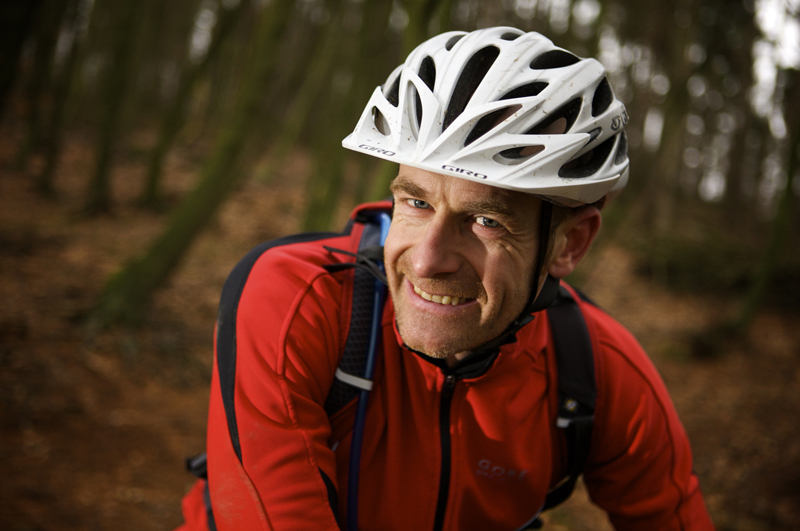Breaking cover on a big scale this year are those 650b/27.5in wheels, and KHS are right in the vanguard with both full suspension and hardtail models.
Ride & handling: Responsive, high traction race or singletrack bike
The low weight is obvious as soon as you kick some life into the pedals – the bike leaps forwards down the trail. Even against similarly light 29ers the decreased wheel inertia is enough to squeeze it ahead in the first few strokes, and it’s not far off flyweight 26ers either.
The stiff mainframe means you can rope in your shoulders to help rage the pedals round, and it’s properly punchy on smash and grab singletrack where you can only get a few cranks in between corners and the rough bits.
Its compact dimensions and low weight mean the KHS is a breeze to chuck around if simply turning isn’t fast or fun enough. There’s no need to turn it in early or take the wide line as with most 29ers (at least until you’re used to them).
It can occasionally wander a bit wide or stay stood up rather than diving into turns immediately when compared to a 26in-wheeled bike, but otherwise KHS have done a great job with their first generation 650b handling.
Before you start wondering whether there’s any point in having the slightly bigger wheels if all we’re saying is how close it is to a 26er for handling, the answer is an unequivocal yes – there is a point. While the monocoque frame, flexy hulled saddle and smooth X-Fusion fork offer a useful degree of vertical compliance, the wheels definitely take the edge off trail chatter and bigger debris (we tried it with 26in wheels to make sure).
Traction is very impressive even when the Racing Ralphs were out of their depth in ploughed-up mud, and the tyres survive rocky terrain at lower pressures than they would in 26er format. We basically had no trouble with the rear tyre clogging, even on filthy autumn rides that left the whole bike pretty much fossilized.
You definitely have to make a lot more steering corrections to keep going forwards in sketchy terrain than you would with a 29er, and it’s not as naturally confident on loose, high-speed descents either.
Interestingly, this is borne out in the results top racer Matt Page got recently, where this KHS significantly outperformed a 26in test bike in all situations but was outstripped slightly by a 29er in faster, more open terrain.

Frame & equipment: All new, 650b specific carbon frame
The frame shows just how heavily KHS is investing in the new size. It isn’t a stretched version of a 26in frame or a shrunken 29in rig, it’s a totally new, full carbon monocoque with many unique features.
The tapered head tube is a given, but the smooth curve of the top tube through the shelf around both the seat tube and into the seatstays is all new. It’s the perfect way to use the longest – and therefore strongest – carbon fibres in a smooth, stress-spreading way.
The large diameter seat tube keeps weight down and strength up, while the rear end uses the latest post-style brake mounts for easy setup. The bottom bracket is a conventional screw-in cup version – which limits chainset choice – but the clamp-on front mech leaves lushly clean lines if you decide to go 1x10 with your transmission.
The kinked down tube gives fork crown clearance and the serious oversizing creates maximum support at the bottom bracket. It actually has a deeply convex underside that hides the cable/brake lines very neatly while reducing the danger of wall flex.
Unfortunately it’s an absolute nightmare for trapping mud, and it rapidly ends up looking like an inverted window box as soon as you hit anything sticky. And what it grows is heavy. We would seriously consider using a strip of gaffer tape to reduce its capacity for scooping in crap in bad weather.
KHS – like everyone else using 650b wheels now – are having to find their own way to the right geometry, and in their numbers you can find similarities with the 26 and 29in bikes in the range.
The 71-degree head angle is the same across all wheel sizes, while the 73-degree seat angle and 16.7in chainstay are shared with the 26in Alite frame. The bottom bracket height is raised to the same height as the 29in Team, and the top tube is halfway between the big stretch of the big wheeler and the shorter reach of the ‘regular’ Alite hardtail.
While KHS run 650b wheels through a full size range, we know other manufactures are planning on using them on the smallest size options in otherwise 29er ranges. They certainly sync better visually with the ‘small for a medium’ sizing of the Team, and the bike feels well balanced on the trail.
KHS rushed us this bike for a feature in sister publication Mountain Biking UK, and as a result it’s neither the £2,499 Team or the £1,799 800 model. But what this XT-based sample does prove is that this chassis creates a seriously light bike without going silly on componentry… Or a very sub-20lb race freak if you do.
What the future holds for the three wheel sizes of today we really don’t know – you, the buyer, will decide that. But insatiably quick and enjoyable bikes like this Team Sixfifty, with its lightweight responsiveness, sparkling agility and tenacious traction are already putting forward a very strong case for the inbetweener option.
This article was originally published in What Mountain Bike magazine, available on Apple Newsstand and Zinio.





